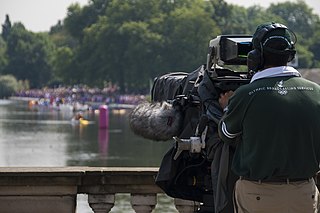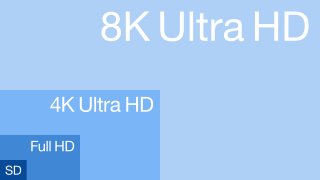Related Research Articles

Synchronised swimming, referred to by international governing body FINA as artistic swimming since 2017, is a hybrid form of swimming, dance, and gymnastics, consisting of swimmers performing a synchronised routine of elaborate moves in the water, accompanied by music. Artistic swimming is governed internationally by FINA, and has been part of the Summer Olympics programme since 1984.

NHK is Japan's national broadcasting organization. NHK, which has always been known by this romanized acronym in Japanese, is a publicly owned corporation funded by viewers' payments of a television license fee.
Genlock is a common technique where the video output of one source is used to synchronize other picture sources together. The aim in video applications is to ensure the coincidence of signals in time at a combining or switching point. When video instruments are synchronized in this way, they are said to be generator-locked, or genlocked.
The Integrated Services Digital Broadcasting is a Japanese standard for digital television (DTV) and digital radio used by the country's radio and television networks. ISDB replaced NTSC-J analog television system and the previously used MUSE Hi-vision analogue HDTV system in Japan, and will be replacing NTSC, PAL-M and PAL-N in South America and the Philippines. Digital Terrestrial Television Broadcasting (DTTB) services using ISDB-T started in Japan in December 2003 and in Brazil in December 2007 as a trial. Since then, many countries have adopted ISDB over other digital broadcasting standards.
The following is a list of video-related topics.

The Athens Olympic Aquatic Centre is a complex at the Athens Olympic Sports Complex, consisting of two outdoor pools and one indoor pool, that was built for the 1991 Mediterranean Games. It was refurbished and expanded for the 2004 Summer Olympics. The larger of the outdoor pools, which seats 11,500 spectators, hosted swimming and water polo events. The smaller pool, which hosted synchronized swimming, sat 5,300 fans. The indoor pool, which hosted the diving events, sat 6,200 observers.
Analog high-definition television was an analog video broadcast television system developed in the 1930s to replace early experimental systems with as few as 12-lines. On 2 November 1936 the BBC began transmitting the world's first public regular analog high-definition television service from the Victorian Alexandra Palace in north London. It therefore claims to be the birthplace of television broadcasting as we know it today. John Logie Baird, Philo T. Farnsworth, and Vladimir Zworykin had each developed competing TV systems, but resolution was not the issue that separated their substantially different technologies, it was patent interference lawsuits and deployment issues given the tumultuous financial climate of the late 1920s and 1930s.

Fully automatic time is a form of race timing in which the clock is automatically activated by the starting device, and the finish time is either automatically recorded, or timed by analysis of a photo finish. The system is commonly used in track and field as well as athletic performance testing, horse racing, dog racing, bicycle racing, rowing and auto racing. In these fields a photo finish is used. It is also used in competitive swimming, for which the swimmers themselves record a finish time by touching a touchpad at the end of a race. In order to verify the equipment, or in case of failure, a backup system is usually used in addition to FAT.

FOR-A is a brand name for professional broadcast video and audio equipment. Founded more than 41 years ago and based in Japan, FOR-A has spread globally, with subsidiaries in America, Canada, Korea, Italy, and the United Kingdom.
High-definition television describes a television system providing an image resolution of substantially higher resolution than the previous generation of technology. The term has been used since 1936, but in modern times refers to the generation following standard-definition television (SDTV), often abbreviated to HDTV. It is the current standard video format used in most broadcasts: terrestrial broadcast television, cable television, satellite television, Blu-ray discs, and streaming video.
Underwater sports is a group of competitive sports using one or a combination of the following underwater diving techniques - breath-hold, snorkelling or scuba including the use of equipment such as diving masks and fins. These sports are conducted in the natural environment at sites such as open water and sheltered or confined water such as lakes and in artificial aquatic environments such as swimming pools. Underwater sports include the following - aquathlon, finswimming, freediving, spearfishing, sport diving, underwater football, underwater hockey, underwater ice hockey, underwater orienteering, underwater photography, underwater rugby, underwater target shooting and underwater video.
Television in Japan was introduced in 1939. However, experiments date back to the 1920s, with Kenjiro Takayanagi's pioneering experiments in electronic television. Television broadcasting was halted by World War II, after which regular television broadcasting began in 1950. After Japan developed the first HDTV systems in the 1960s, MUSE/Hi-Vision was introduced in the 1970s.

Olympic Broadcasting Services (OBS) is a company which was established by the International Olympic Committee in 2001 in order to serve as the Host Broadcaster organisation for all Olympic Games, Olympic Winter Games and Youth Olympic Games, maintaining the standards of Olympic broadcasting between one edition and the next one.

8K resolution refers to an image or display resolution with a width of approximately 8000 pixels. 8K UHD is the highest resolution defined in the Rec. 2020 (UHDTV) standard.

Synchronized swimming competitions at the 2012 Summer Olympics in London were held from Sunday 5 August to Friday 10 August, at the London Aquatics Centre. Two medal events were included in the programme — women's duet and women's team — with 100 athletes participating.
Olga "Olia" Burtaev is an Australian synchronised swimmer. Burtaev joined Australia's National Team at 14 years of age, and made her international debuts at the 2010 Swiss Open and the 2010 FINA Synchronised Swimming World Cup. Burtaev competed for Australia at the 2012 Summer Olympics, and represented the nation at the 2011 and 2013 World Aquatics Championships.

ITU-R Recommendation BT.2020, more commonly known by the abbreviations Rec. 2020 or BT.2020, defines various aspects of ultra-high-definition television (UHDTV) with standard dynamic range (SDR) and wide color gamut (WCG), including picture resolutions, frame rates with progressive scan, bit depths, color primaries, RGB and luma-chroma color representations, chroma subsamplings, and an opto-electronic transfer function. The first version of Rec. 2020 was posted on the International Telecommunication Union (ITU) website on August 23, 2012, and two further editions have been published since then. It is expanded in several ways by Rec. 2100.

Japan competed at the 2013 World Aquatics Championships in Barcelona, Spain between 19 July and 4 August 2013.

Ultra-high-definition television today includes 4K UHD and 8K UHD, which are two digital video formats with an aspect ratio of 16:9. These were first proposed by NHK Science & Technology Research Laboratories and later defined and approved by the International Telecommunication Union (ITU). It is a digital television (DTV) standard, and the successor to high-definition television (HDTV), which in turn was the successor to standard-definition television (SDTV).

"Hero" is a song by Japanese recording artist Namie Amuro. It was released as a stand-alone single on July 27, 2016 by Avex Trax and Amuro’s own label Dimension Point; it was distributed physically in Japan and Taiwan, and digitally worldwide. The song was written by Ryosuke Imai and Sunny Boy, whilst production and composing was handled by the latter collaborator. Originally slated to appear as a B-side track to her previous single "Mint", it served as the official Japanese theme song to the 2016 Summer Olympics and Paralympics, broadcast by the NHK. Alongside this, a B-side track titled "Show Me What You’ve Got" appeared on the release of "Hero".
References
- ↑ Ben Johnson (2012-08-11). "The Camera They're Using to Show Synchronized Swimming Is an Amazing Tech Innovation". Slate. Retrieved 2012-08-11.
- ↑ Gavin J. Blair (2012-08-01). "London 2012: Public Broadcaster NHK Leading Olympics Coverage in Japan". Hollywood Reporter. Retrieved 2012-08-11.